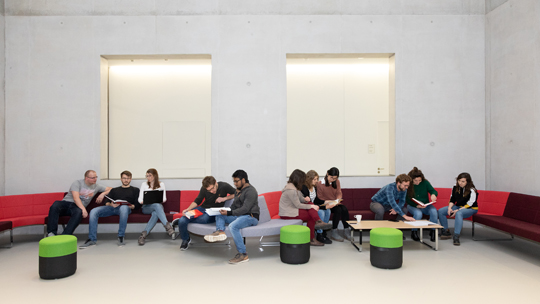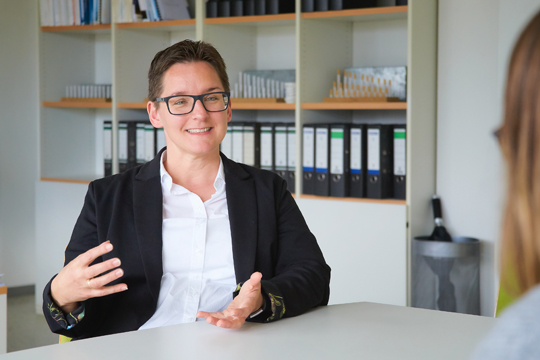Room for new ideas
Freiburg, Feb 25, 2019
Whether in the kitchenette or on the way to the cafeteria, the best ideas often do not come directly from the workplace. Its design, however, can inspire creative excellence. Prof. Dr. Andrea Kiesel from the Institute of Psychology develops new spaces with colleagues for the University’s future strategy “Connecting Creative Minds” in order to promote the creativity of all students, researchers and employees. Sonja Seidel spoke with Kiesel about what characterizes creativity and how rooms must be designed so that people can fully exploit their creative potential.

Photo: Ingeborg Lehmann
Ms. Kiesel, what exactly is creativity?
Andrea Kiesel: From a psychological standpoint, the term has two different meanings. On the one hand, it can be a person’s permanent personality trait. But there is also a creative mindset, i.e. a mental state characterized by so-called divergent thinking. “Out of the box” people think about different possibilities. Creativity is always based on knowledge and skills that someone has. The human being restructures these in the creative process so that something new can emerge from them. This state is always functional. So it is not about some kind of fantasy, but about a free mode of thinking, which is intended to produce a result.
What is required to reach this mindset?
First and foremost, the person must feel good. Many studies show that people in a positive mood are more easily creative. Physiologically, people must also be in good condition. They should not be hungry and the room temperature should be comfortable. They also require a stimulating environment from which they receive ideas. Our University Library, for example, offers such things. There are no square rooms and no clear room structure with doors. There are different types of furniture and a clear view outside. Time is also very important for creativity and the connection with other people. That’s what we want to achieve with “Connecting Creative Minds.” We want to create temporal freedom and develop appropriate spaces in which people can work creatively.
Some companies now rely on special rooms in which employees can playfully come up with new ideas, for example by working with Lego bricks. Does this really encourage creativity?
Of course you can use unusual tools to come up with new ideas. Sometimes you have to dissolve typical thinking structures. But it must also fit the problem. When I say that the Lego bricks symbolize certain business processes and I mix and reassemble them, it might be helpful. But there is no single solution for creativity. You always need the expertise and knowledge to structure a problem sufficiently and get out of this stuck system. I can support that with all kinds of assistance materials.

To be creative, people need time – and the connection with other people, says Andrea Kiesel. Photo: Harald Neumann
What is the particular challenge with the University’s spaces?
The challenge is that you need different types of rooms at the University. When I work alone on a project and program, for example, I need a quiet place. There I can be as creative as possible for this specific kind of problem-solving. Researchers need such quiet workspaces. But students also need places where they can study alone or write homework. But that’s only part of the actual reality at universities. Today, most scientists work in groups. This requires meeting rooms with different functions.
What type of features should such spaces have?
I need some spaces in which I can first think about a project in detail, and I need some spaces in which I can sit down with others to make decisions. In the building of the Freiburg Center for Interactive Materials and Bioinspired Technologies, for example, they have succeeded in combining different rooms. There are laboratories, behind them small workplaces where you can write, and quiet offices. In the center are areas where people can meet and discuss. Both in closed meeting rooms and in open spaces.
What is particularly important to you during the planning phase?
We need more flexible spatial concepts. These include, for example, tables that can be moved to make room for a whiteboard to sketch ideas. We currently have many rooms at the University for quiet work, so you don’t have to negate them completely. What we still lack at the moment are so-called open spaces for good meeting situations. We need to use the space we have more creatively. I think we can create great things with little effort.
So it’s about giving people different options.
Exactly. One consideration, for example, is to find places at the University where people meet anyway, simply because their paths cross. For example, students and employees on their way to the cafeteria. Because creativity also arises in places where people happen to be. Kitchens, for example, are a classic place for this spontaneous creativity. But creativity also arises in a desired setting in which a group meets. Unplanned kinds of interaction are often difficult at the University. Perhaps we can find better ways to get into conversation with people by seeking where their paths cross.

